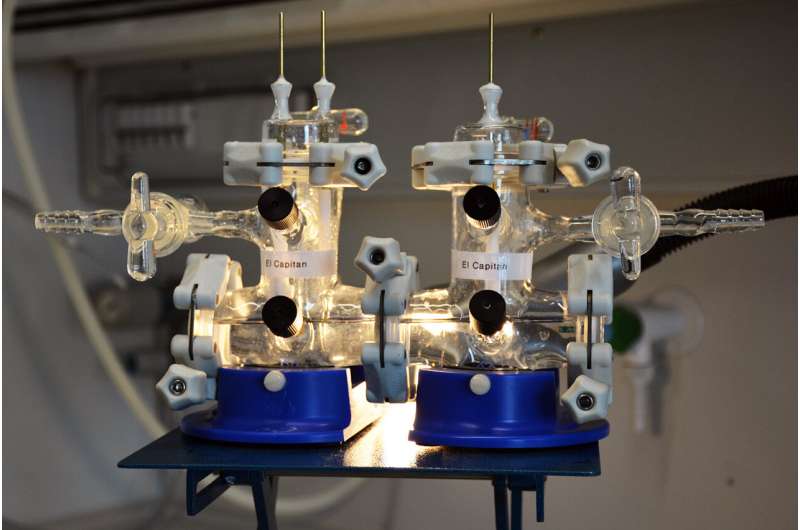This article has been reviewed according to Science X's editorial process and policies. Editors have highlighted the following attributes while ensuring the content's credibility:
fact-checked
trusted source
proofread
Using MOCHAs to turn greenhouse gas into a value-added product

Thinking of CO2, terms like climate-damaging or waste product probably quickly come to mind. While CO2 has been that for a long time—a pure waste product—more and more processes are being developed with which the greenhouse gas can be converted into valuable raw materials. Researchers then speak of "value-added chemicals." A new material that makes this possible was developed at TU Wien and recently presented in the journal Communications Chemistry.
Researchers at Prof. Dominik Eder's group developed a new material that facilitates the conversion of CO2. These are MOCHAs—organometallic chalcogenolate compounds that serve as catalysts. The result of the electrochemical conversion is synthesis gas, or syngas for short, which is an important raw material for the chemical industry.
CO2 becomes synthesis gas
Syngas is a mixture of carbon monoxide (CO), hydrogen (H2) and other gases and is used as a basic material for other substances. One of the most important fields of application is fertilizer production, in which ammonia is produced from syngas. However, it can also be used for the production of fuels such as diesel or for the production of methanol, which is used in fuel cells. Since the extraction of CO2 from the atmosphere is quite energy-intensive, taking CO2 from industrial plants is a good option. From there, it can serve as a starting material for various chemicals.
However, previous methods require high temperatures and pressures as well as expensive catalysts. Therefore, the Viennese researchers were looking for catalysts that can also be used to produce syngas at low temperatures and atmospheric pressure.
"MOCHAs work differently than the catalysts used so far: Instead of heat, electricity is supplied to activate the catalyst and trigger the conversion of CO2 into synthesis gas," explains Junior Group Leader Dogukan Apaydin, who is responsible for research efforts towards CO2 conversion in the research group.
MOCHAs as problem solvers
MOCHAs are a material class that was developed almost 20 years ago but has not yet found any application. The organic-inorganic hybrid materials have gained popularity again in recent years. The TU researchers recognized the potential of MOCHAs as catalysts and conducted experiments with them for the first time. However, they encountered some problems: Previous synthesis methods only yielded small amounts of product and required a lot of time. "With the help of our synthesis method, we were able to significantly increase the amount of product and reduce the time from 72 to five hours," Apaydin explains.
Initial tests showed that the catalytic performance of MOCHAs in the production of synthesis gas from CO2 is comparable to previously established catalysts. Moreover, they require much less energy, as the entire reaction can be carried out at room temperature. In addition, MOCHAs prove to be extremely stable. They can be used in different solvents, at different temperatures or under different pH conditions and retain their structure even after catalysis.
Nevertheless, there are some parameters that the team around Dogukan Apaydin and Ph.D. student Hannah Rabl continue to research. If the same electrodes are used several times to supply energy in the form of power, there is a slight drop in performance. How the connection between MOCHAs and electrodes can be further improved to prevent this drop in performance is now being researched in long-term experiments.
"We are still at an early stage of application," Dogukan Apaydin admits. "I like to compare this with solar panels, which were much more complex and expensive to produce 30 years ago than today. But with the right infrastructure and political will, MOCHAs can also be widely used in the future to convert CO2 into synthesis gas and thus make their contribution to climate protection."
More information: Hannah Rabl et al, Microwave-assisted synthesis of metal-organic chalcogenolate assemblies as electrocatalysts for syngas production, Communications Chemistry (2023). DOI: 10.1038/s42004-023-00843-3
Provided by Vienna University of Technology





















